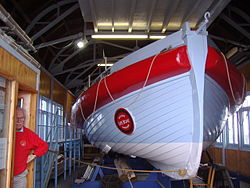 Alfred Corry | |
| History | |
|---|---|
| | |
| Owner | Alfred Corry Lifeboat Museum |
| Builder | Beeching Brothers of Great Yarmouth |
| Official RNLI Number | ON 353 |
| Station | Southwold |
| Cost | £490.7s.4d. |
| Laid down | 1893 |
| Launched | 1894 |
| Sponsored by | From the estate of Mr Alfred J Corry |
| Decommissioned | 1918 |
| In service | 25 |
| Fate | Converted to a Gentleman's Yacht until restoration began in 1976 |
| General characteristics | |
| Class & type | Norfolk and Suffolk-Type |
| Type | Non-self-righting, sailing and rowing lifeboat |
| Displacement | 8 tons |
| Length | 44 ft 1 in (13.44 m) overall |
| Beam | 13 ft 0 in (3.96 m) |
| Draught | 2 ft 3.5 in (0.699 m) |
| Depth | 4 ft 10 in (1.47 m) |
| Installed power | Sail and Oars |
| Crew | 18 men |
RNLB Alfred Corry (ON 353) is a Norfolk and Suffolk-class, non-self-righting, sailing and rowing lifeboat which served in the town of Southwold in the county of Suffolk. [1] [2] The boat was funded and crewed by the Royal National Lifeboat Institution (RNLI). She is kept on display in a museum in Southwold. [3] [4]